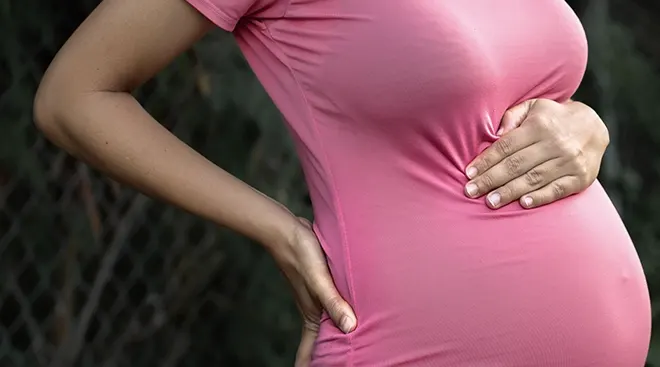What Is PUPPP Rash in Pregnancy?
Imagine being just weeks away from delivering; you’re tired and feeling huge, when suddenly you contract an extremely itchy, hive-like rash that flares up all around your belly, keeping you up at night as you scratch, scratch, scratch to seek relief. For the one in 160 to 300 pregnant women afflicted by it, PUPPP rash tops the list of the most agonizing parts of pregnancy.
So what’s the deal with PUPPP rash, which—with its bumpy, veiny streaks—looks as terrible as it feels? We asked a series of experts to weigh in on what may cause the skin rash, when you can expect it to dissipate and how pregnant people experiencing even the worst cases of PUPPP in pregnancy can find some fast relief.
PUPPP, medically known as pruritic urticarial papules and plaques of pregnancy, is the most common rash to occur during pregnancy, says Christine Greves, MD, an ob-gyn at Orlando Health Winnie Palmer Hospital for Women & Babies. PUPPP rash shows up as small, raised bumps nestled in the stretch marks on your stomach and may spread to other parts of your body. “It can be extremely debilitating,” says Ashanda Saint Jean, MD, chair of the obstetrics department at HealthAlliance of the Hudson Valley and an associate professor at New York Medical College.
About 75 percent of PUPPP rash cases occur in first-time moms some time during the third trimester, notes Saint Jean—typically around 32 to 35 weeks of gestation. There are some cases where PUPPP rash appears in the first or second trimester, but that’s less common. Rarely, it can also pop up postpartum.
“The good news is there’s no risk to baby or Mom with PUPPP,” says Utsavi Shah, MD, an assistant professor of obstetrics and gynecology at Baylor College of Medicine. “But that’s not to say that it’s not extremely uncomfortable.”
No one knows for sure what causes PUPPP rash, but it’s likely related to the significant stretching and expansion of skin that occurs as your belly gets bigger during pregnancy, explains Nada Elbuluk, MD, a board-certified dermatologist and assistant professor at the USC Keck School of Medicine. “It’s more common with excessive stretching—like with women who are having twins or multiples where there’s more stretching going on,” says Shah. “The hypothesis is that the stretching is damaging to the connective tissue and it triggers inflammatory cells in the skin, which causes the rash,” she adds.
According to Elbuluk, there are certain factors that make one more susceptible to PUPPP rash. You might be at an increased risk if:
- You’re pregnant for the first time
- You gain significant weight during pregnancy
- You’re having twins or multiples
- You’re expecting a boy
- You’re caucasian
“The pathological cause of why some people have more stretching than others is a mix of genetics and skin composition and size of your pregnancy,” says Shah. Research also suggests that PUPPP rash might stem from a pregnant person’s immune response to their baby’s antigens, she adds. So far researchers say that pregnancy hormones likely don’t play a role in the hive-like lesions flaring up.
The most common PUPPP rash symptom is extreme itchiness. The hallmark look of PUPPP is a patch of raised bumps within stretch marks, which can “combine and coalesce to form what we call plaques,” explains Shah. The rash tends to evolve over a few days, starting at the abdomen and spreading to a patient’s chest, back, arms and thighs; in some patients, the rash remains around the belly area. PUPPP rash typically doesn’t show up on your face, palms or feet.
What does PUPPP rash look like?
PUPPP rash can look different on everyone. For those with darker skin, the bumps and patches might be skin-colored, dark brown or purple with less redness, says Elbuluk. With lighter skin, PUPPP rash bumps may appear as reddish, pinkish or violet. The key to identifying PUPPP rash: the raised patches are intensely itchy.
It’s far from pleasant, but there is some reassuring news: The rash will gradually go away on its own. That said, it can last between four to six weeks, and it may not dissipate until after baby comes, says Greves.
PUPPP rash pictures
Below, a few different presentations of PUPPP rash:
Your doctor can typically tell if you have PUPPP rash with a physical exam and by evaluating your medical history. And if this is not your first time expecting, they’ll likely ask if you’ve had PUPPP rash before with previous pregnancies. They’ll also check for symptoms that could denote more serious ailments. For example, if the itching is isolated to your palms or soles of your feet, and you don’t have much of a rash, they’ll probably run a blood test to rule out cholestasis of pregnancy, a potentially severe liver illness that occurs in late pregnancy, explains Saint Jean.
Your provider will also ask about any nuances in your daily life that may have recently changed and could be causing a rash—like if you’re using a new laundry detergent, facial soap or perfume.
Your PUPPP rash treatment will vary depending on how itchy and uncomfortable you are. If it’s bad, your doctor may immediately prescribe a steroid cream or ointment to rub on your belly once or twice daily, says Shah. If that doesn’t help, they may suggest a short course of oral steroids.
Some providers prefer to start patients with an over-the-counter antihistamine like Zyrtec or Claritin; they may also suggest Benadryl for someone looking for relief at nighttime when itchiness seems worse, notes Shah.
Looking for some PUPPP rash home remedies? You can treat your PUPPP rash as you would with any other common itchy-skin affliction. Greves suggests placing cold compresses against the rash or taking an oatmeal bath, as the grain has been shown to yield anti-inflammatory compounds that may help soothe irritated skin.
Other lifestyle changes that can help are applying fragrance-free moisturizers or petroleum jelly-based lotions and wearing loose clothing, says Shah. “We encourage our patients to try aloe vera gel, which you can purchase over the counter or may have as a plant at home,” says Saint Jean. “It’s clear jelly is so soothing and cathartic.”
It’s rare, but yes, you can develop a PUPPP rash immediately after baby is born, says Elbuluk. “After you deliver a baby your body doesn’t go back right away; your skin is still loose, your uterus still enlarged, and fetal antigens still may be circulating,” said Shah.
Most people see their PUPPP rash dissipate within about two weeks after delivery, but it may take longer, Greves reiterates. The rash should disappear completely without leaving scarring or any color behind, unless your scratching has caused scabs. Of course, those pesky stretch marks may linger too. “Just know that [your PUPPP rash] will get better,” says Shah. “But it’s not like a light switch; it doesn’t just magically turn off and stop.”
Please note: The Bump and the materials and information it contains are not intended to, and do not constitute, medical or other health advice or diagnosis and should not be used as such. You should always consult with a qualified physician or health professional about your specific circumstances.
Plus, more from The Bump:
Nada Elbuluk, MD, is a board-certified dermatologist and assistant professor at the USC Keck School of Medicine. She received her medical degree from the University of Michigan.
Christine Greves, MD, is an ob-gyn at Orlando Health Winnie Palmer Hospital for Women & Babies. She received her medical degree from the University of South Florida.
Ashanda Saint Jean, MD, is chair of the obstetrics department at HealthAlliance of the Hudson Valley and an associate professor at the New York Medical College, where she also received her medical degree.
Utsavi Shah, MD, is an assistant professor of obstetrics and gynecology at Baylor College of Medicine in Houston. She also received her medical degree there.
Learn how we ensure the accuracy of our content through our editorial and medical review process.
Navigate forward to interact with the calendar and select a date. Press the question mark key to get the keyboard shortcuts for changing dates.























































